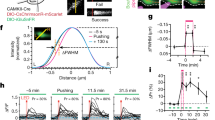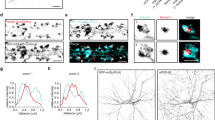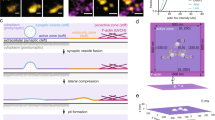Abstract
Many neural signaling receptors are regulated by endocytosis, but little is known about receptor insertion into the plasma membrane. Time-lapse imaging of the β2 adrenergic receptor expressed in cultured rat hippocampal neurons, using pH-sensitive green fluorescent protein tagging and total internal reflection fluorescence microscopy, resolved distinct vesicular fusion events mediating receptor insertion into the somatodendritic plasma membrane. A 'transient' insertion mode resulted in rapid lateral dispersion of receptors immediately after insertion. A 'persistent' insertion mode resulted in the retention of inserted receptors in surface-accessible domains, which were relatively immobile for a prolonged 'wait' period before dispersing laterally. Distinct insertion modes were oppositely regulated by receptor activation and by mechanisms differing in their dependence on the signaling effector cyclic AMP–dependent protein kinase. These results reveal a new mechanism for homeostatic regulation of postsynaptic signaling and a 'kiss-and-wait' mode of regulated membrane protein insertion in neurons.
This is a preview of subscription content, access via your institution
Access options
Subscribe to this journal
Receive 12 print issues and online access
$209.00 per year
only $17.42 per issue
Buy this article
- Purchase on Springer Link
- Instant access to full article PDF
Prices may be subject to local taxes which are calculated during checkout





Similar content being viewed by others
References
Scannevin, R.H. & Huganir, R.L. Postsynaptic organization and regulation of excitatory synapses. Nat. Rev. Neurosci. 1, 133–141 (2000).
Carroll, R.C., Beattie, E.C., von Zastrow, M. & Malenka, R.C. Role of AMPA receptor endocytosis in synaptic plasticity. Nat. Rev. Neurosci. 2, 315–324 (2001).
Malinow, R. & Malenka, R.C. AMPA receptor trafficking and synaptic plasticity. Annu. Rev. Neurosci. 25, 103–126 (2002).
Song, I. & Huganir, R.L. Regulation of AMPA receptors during synaptic plasticity. Trends Neurosci. 25, 578–588 (2002).
Sorkin, A. & Von Zastrow, M. Signal transduction and endocytosis: close encounters of many kinds. Nat. Rev. Mol. Cell Biol. 3, 600–614 (2002).
Sheng, M. & Kim, M.J. Postsynaptic signaling and plasticity mechanisms. Science 298, 776–780 (2002).
Malenka, R.C. The long-term potential of LTP. Nat. Rev. Neurosci. 4, 923–926 (2003).
Nicoll, R.A. & Schmitz, D. Synaptic plasticity at hippocampal mossy fibre synapses. Nat. Rev. Neurosci. 6, 863–876 (2005).
Keith, D.E. et al. mu-Opioid receptor internalization: opiate drugs have differential effects on a conserved endocytic mechanism in vitro and in the mammalian brain. Mol. Pharmacol. 53, 377–384 (1998).
Whistler, J.L. & von Zastrow, M. Morphine-activated opioid receptors elude desensitization by beta-arrestin. Proc. Natl. Acad. Sci. USA 95, 9914–9919 (1998).
Carroll, R.C. et al. Dynamin-dependent endocytosis of ionotropic glutamate receptors. Proc. Natl. Acad. Sci. USA 96, 14112–14117 (1999).
Beattie, E.C. et al. Regulation of AMPA receptor endocytosis by a signaling mechanism shared with LTD. Nat. Neurosci. 3, 1291–1300 (2000).
Shi, S.H. et al. Rapid spine delivery and redistribution of AMPA receptors after synaptic NMDA receptor activation. Science 284, 1811–1816 (1999).
Kim, K.A. & von Zastrow, M. Neurotrophin-regulated sorting of opioid receptors in the biosynthetic pathway of neurosecretory cells. J. Neurosci. 23, 2075–2085 (2003).
Guan, J.S. et al. Interaction with vesicle luminal protachykinin regulates surface expression of delta-opioid receptors and opioid analgesia. Cell 122, 619–631 (2005).
Adesnik, H., Nicoll, R.A. & England, P.M. Photoinactivation of native AMPA receptors reveals their real-time trafficking. Neuron 48, 977–985 (2005).
Gainetdinov, R.R., Premont, R.T., Bohn, L.M., Lefkowitz, R.J. & Caron, M.G. Desensitization of G protein-coupled receptors and neuronal functions. Annu. Rev. Neurosci. 27, 107–144 (2004).
Davare, M.A. et al. A beta2 adrenergic receptor signaling complex assembled with the Ca2+ channel Cav1.2. Science 293, 98–101 (2001).
Yu, S.S., Lefkowitz, R.J. & Hausdorff, W.P. Beta-adrenergic receptor sequestration. A potential mechanism of receptor resensitization. J. Biol. Chem. 268, 337–341 (1993).
Pippig, S., Andexinger, S. & Lohse, M.J. Sequestration and recycling of beta 2-adrenergic receptors permit receptor resensitization. Mol. Pharmacol. 47, 666–676 (1995).
Lefkowitz, R.J., Pitcher, J., Krueger, K. & Daaka, Y. Mechanisms of beta-adrenergic receptor desensitization and resensitization. Adv. Pharmacol. 42, 416–420 (1998).
Pierce, K.L. & Lefkowitz, R.J. Classical and new roles of beta-arrestins in the regulation of G-protein-coupled receptors. Nat. Rev. Neurosci. 2, 727–733 (2001).
Xiang, Y. & Kobilka, B. The PDZ-binding motif of the beta2-adrenoceptor is essential for physiologic signaling and trafficking in cardiac myocytes. Proc. Natl. Acad. Sci. USA 100, 10776–10781 (2003).
Hanyaloglu, A.C., McCullagh, E. & von Zastrow, M. Essential role of Hrs in a recycling mechanism mediating functional resensitization of cell signaling. EMBO J. 24, 2265–2283 (2005).
Goodman, O.B., Jr. et al. Beta-arrestin acts as a clathrin adaptor in endocytosis of the beta2-adrenergic receptor. Nature 383, 447–450 (1996).
Ferguson, S.S. et al. Role of beta-arrestin in mediating agonist-promoted G protein-coupled receptor internalization. Science 271, 363–366 (1996).
Cao, T.T., Deacon, H.W., Reczek, D., Bretscher, A. & von Zastrow, M. A kinase-regulated PDZ-domain interaction controls endocytic sorting of the beta2-adrenergic receptor. Nature 401, 286–290 (1999).
Shenoy, S.K., McDonald, P.H., Kohout, T.A. & Lefkowitz, R.J. Regulation of receptor fate by ubiquitination of activated beta 2- adrenergic receptor and beta-arrestin. Science 294, 1307–1313 (2001).
Whistler, J.L. et al. Modulation of post-endocytic sorting of G protein-coupled receptors. Science 297, 615–620 (2002).
Miesenbock, G., De Angelis, D.A. & Rothman, J.E. Visualizing secretion and synaptic transmission with pH-sensitive green fluorescent proteins. Nature 394, 192–195 (1998).
Sankaranarayanan, S., De Angelis, D., Rothman, J.E. & Ryan, T.A. The use of pHluorins for optical measurements of presynaptic activity. Biophys. J. 79, 2199–2208 (2000).
Steyer, J.A. & Almers, W. A real-time view of life within 100 nm of the plasma membrane. Nat. Rev. Mol. Cell Biol. 2, 268–275 (2001).
Merrifield, C.J., Feldman, M.E., Wan, L. & Almers, W. Imaging actin and dynamin recruitment during invagination of single clathrin-coated pits. Nat. Cell Biol. 4, 691–698 (2002).
Axelrod, D., Koppel, D.E., Schlessinger, J., Elson, E. & Webb, W.W. Mobility measurement by analysis of fluorescence photobleaching recovery kinetics. Biophys. J. 16, 1055–1069 (1976).
Hegener, O. et al. Dynamics of beta2-adrenergic receptor-ligand complexes on living cells. Biochemistry 43, 6190–6199 (2004).
Hoogland, T.M. & Saggau, P. Facilitation of L-type Ca2+ channels in dendritic spines by activation of beta2 adrenergic receptors. J. Neurosci. 24, 8416–8427 (2004).
Xiang, Y. & Kobilka, B.K. Myocyte adrenoceptor signaling pathways. Science 300, 1530–1532 (2003).
Klyachko, V.A. & Jackson, M.B. Capacitance steps and fusion pores of small and large-dense-core vesicles in nerve terminals. Nature 418, 89–92 (2002).
Holroyd, P., Lang, T., Wenzel, D., De Camilli, P. & Jahn, R. Imaging direct, dynamin-dependent recapture of fusing secretory granules on plasma membrane lawns from PC12 cells. Proc. Natl. Acad. Sci. USA 99, 16806–16811 (2002).
Taraska, J.W., Perrais, D., Ohara-Imaizumi, M., Nagamatsu, S. & Almers, W. Secretory granules are recaptured largely intact after stimulated exocytosis in cultured endocrine cells. Proc. Natl. Acad. Sci. USA 100, 2070–2075 (2003).
Gandhi, S.P. & Stevens, C.F. Three modes of synaptic vesicular recycling revealed by single-vesicle imaging. Nature 423, 607–613 (2003).
Aravanis, A.M., Pyle, J.L. & Tsien, R.W. Single synaptic vesicles fusing transiently and successively without loss of identity. Nature 423, 643–647 (2003).
Ryan, T.A. Kiss-and-run, fuse-pinch-and-linger, fuse-and-collapse: the life and times of a neurosecretory granule. Proc. Natl. Acad. Sci. USA 100, 2171–2173 (2003).
von Zastrow, M. & Kobilka, B.K. Ligand-regulated internalization and recycling of human beta 2-adrenergic receptors between the plasma membrane and endosomes containing transferrin receptors. J. Biol. Chem. 267, 3530–3538 (1992).
Brewer, G.J., Torricelli, J.R., Evege, E.K. & Price, P.J. Optimized survival of hippocampal neurons in B27-supplemented Neurobasal, a new serum-free medium combination. J. Neurosci. Res. 35, 567–576 (1993).
Acknowledgements
The authors thank R. Edwards, T. Ryan, N. Stuurman and R. Vale for valuable discussions; J. Rothman (Columbia University, New York) for providing pH-sensitive GFP constructs; W. Almers (Vollum Institute, Portland, Oregon) for the DsRed-tagged clathrin light chain construct; A. Douglass and A. Marley for constructing SpH-β2AR, and B. Lauffer (all University of California San Francisco, San Francisco) for β2AR antiserum; P. Herzmark for use of the objective warmer; and H. Bourne and R. Nicoll for critical comments on the manuscript. These studies were supported by research grants from the US National Institutes of Health and the National Institute on Drug Abuse. G.A.Y. was supported in part by the Pew Latin American Fellows Program.
Author information
Authors and Affiliations
Corresponding author
Ethics declarations
Competing interests
The authors declare no competing financial interests.
Supplementary information
Supplementary Fig. 1
Functional integrity of SpH–B2AR and expression in cultured neurons. (PDF 51 kb)
Supplementary Fig. 2
Plasma membrane targeting, ligand–induced internalization and surface localization of SpH–B2AR in hippocampal neurons. (PDF 141 kb)
Supplementary Fig. 3
Recycling sequence–dependence and MES accessibility of SpH–B2AR insertion events. (PDF 75 kb)
Supplementary Video 1
Sequential TIRF images from hippocampal neurons expressing SpH–B2AR and exposed to 10 μM isoproterenol for 10 minutes prior to imaging. Interval between frames is 100 ms. (QT 12880 kb)
Supplementary Video 2
A region of the plasma membrane showing examples of 'transient' (circled in red) and 'persistent' (circled in green) SpH–B2AR insertion events occurring in adjacent regions of the somatic plasma membrane. Hippocampal neurons were exposed to 10 μM isoproterenol for 10 minutes prior to sequential TIRF imaging (100 ms / frame). Trace below the movie shows peak pixel intensity in each circled region of the plasma membrane over time. (QT 13413 kb)
Supplementary Video 3
Example of a persistent SpH–B2AR insertion event occurring on a proximal dendrite. A number of transient insertion events are seen in the somatic plasma membrane also present in the image series. Hippocampal neurons were exposed to 10 μM isoproterenol for 10 minutes prior to sequential TIRF imaging (100 ms / frame). (QT 1403 kb)
Supplementary Video 4
Example of a transient SpH–B2AR insertion event occurring on a distal dendrite. Interval between frames is 100 ms. (QT 702 kb)
Supplementary Video 5
Transient SpH–B2AR insertion event in a distal dendrite (corresponding to that analyzed in Fig. 3 c and d). Interval between frames is 100 ms. (QT 242 kb)
Rights and permissions
About this article
Cite this article
Yudowski, G., Puthenveedu, M. & von Zastrow, M. Distinct modes of regulated receptor insertion to the somatodendritic plasma membrane. Nat Neurosci 9, 622–627 (2006). https://doi.org/10.1038/nn1679
Received:
Accepted:
Published:
Issue Date:
DOI: https://doi.org/10.1038/nn1679
This article is cited by
-
NMDAR-dependent long-term depression is associated with increased short term plasticity through autophagy mediated loss of PSD-95
Nature Communications (2021)
-
Catalytic activation of β-arrestin by GPCRs
Nature (2018)
-
Desensitized D2 autoreceptors are resistant to trafficking
Scientific Reports (2017)
-
Selected SNARE proteins are essential for the polarized membrane insertion of igf-1 receptor and the regulation of initial axonal outgrowth in neurons
Cell Discovery (2015)
-
Ligand-specific endocytic dwell times control functional selectivity of the cannabinoid receptor 1
Nature Communications (2014)



